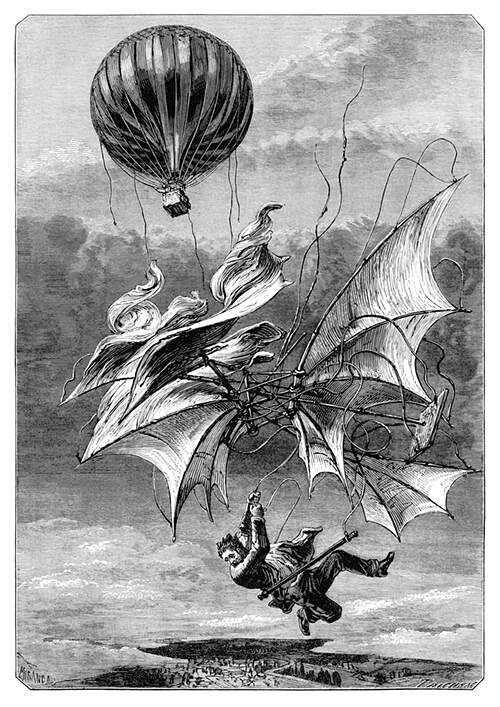1874 The death of an aeronaut
The London Daily Telegraph made the following report:
It was announced yesterday that, at 7.30 p.m., M. de Groof, the “Flying Man” would repeat at the Cremorne Gardens “his astounding performance of flying through the air a distance of 5,000 feet.” True to this announcement, the Flying Man did endeavour to repeat the exploit which he had accomplished in safety ten days before, and perished in the attempt.

M. de Groof was a Belgian, who had expended years in constructing for himself an apparatus with which he believed it possible to imitate the flight of a bird. The general outline of this apparatus was an immitation of a bat’s wings, the framework being made of cane, and the intervening membrane of stout waterproof silk. The wings were in all 37 feet long, with an average breadth of 4 feet, while the tail was 18 feet by 3. These wings were inserted into two hinged frames that were attached to a wooden stand upon which the aeronaut took his place. Here he had three levers which he worked by hand to give his machine propulsion or guidance as might be required; his theory being that having started from a given height, he could manage his descent so as to reach the earth by a sort of inclined swooping motion, without risk of concussion.
About a year ago M. de Groof made an attempt, of which our correspondent at the time telegraphed the particulars. to descend from a great neight on the Grande Place at Brussels. The effort was a failure, but l’Homme Volant as he was then called, escaped unhurt, though his network was afterwards torn in pieces by the crowd. On Monday, the 20th ultimo, however, M. de Groof repeated his experiment at Cremorne Gardens, with success. Mr. Baum, tho proprietor of the gardens, had, it seems, after making an engagement with him, felt some uneasiness as to the result, and at first refused to allow the trial to be made. The “Flying Man” protested the absolute feasibility of his scheme, and insisted on the contract being carried out; and this was done. The wings and stand were attached to a balloon guided by Mr. Simmons, who, after drifting over London towards Brandon, in Essex, released his companion at a considerable height—three or four hundred feet, it is said—and the flying apparatus was immediately set in motion. “For a time” it is stated, “it was a race between the aeronaut and the flyer, De Groof winning by two flelds’ lengths, and attaining the ground in perfect safety.”
How the accident occurred last night cannot be clearly ascertained. The apparatus, previous to the ascent, seemed in satisfactory order, and De Groof—though, according to custom, he took an affectionate farewell of his wife—appeared fully confident of making a successful ascent. About a quarter to 8 o’clock the balloon was cut loose, and rose slowly in the air, bearing with it the Flying Man and his gear. There was hardly a breath of air, a circumstance which might have been supposed to be favourable to the performance of an aeronautical feat of the kind. Be this as it may, however, when the balloon had attained a height of three or four hundred feet, the unfortunate performer seemed either to mistrust his own powers or the capability of his apparatus, for he was heard by the spectators below shouting to the man in the balloon to bring him nearer the earth. This request was complied with, and the balloon descended slowly towards Robert-street, which lies a quarter of a mile or so to the north of Cremorne Gardens. On approaching St. Luke’s Church, Mr. Simmons, the balloonist, was heard to say: “Yon must cut loose now, or you’ll come on the church roof.” The answer was, “Yes; let me drop into the churchyard,” and these were, no doubt, the last words De Groof uttered.
He cut the rope when about eighty feet from the ground, but, to the horror of the spectators, who must have numbered many thousand, the apparatus, instead of inflating with the pressure of the air, collapsed, and, turning round and round in its descent, fell with great violence in Robert-street, a yard or two from the kerbstone. Assistance to the unfortunate man was instantly forthcoming. Although still breathing, he was insensible; but the despatch with which he was extricated from the wreck of his apparatus and conveyed to Chelsea Infirmary proved in vain. He never recovered consciousness, and on his arrival at the hospital the surgeons pronounced him dead, Madame de Groof, who witnessed her husband’s fall, fainted at the sight, and a still more painful scene took place a short time later at the hospital, when she learned the whole sad truth.
The apparatus was carried off in shreds by the crowd before the police could secure it. From the hospital the body was removed to the dead-house, where it now awaits the inquest. It only remains to add that the balloon, on being freed from the weight of De Groof and his flying machine, soared away over the metropolis in a north-easterly direction; and, at dark, was seen at a great height above Victoria Park, where it was watched with much interest by large numbers of people, who were, of course, ignorant of the shocking tragedy in which it had played a part.